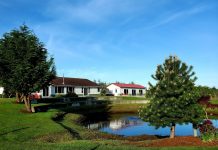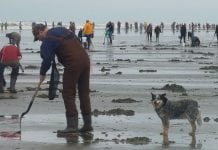Submitted by Chehalis Lead Entity
Robert and Lecia Criswell have lived in the rural upper Wynoochee Valley for a combined total of more than 120 years. Fifty-seven years ago, Robert’s parents moved from Arkansas to teach at Grisdale, the last logging camp in the United States. Robert said, “I moved to the valley because I thought it was a good idea to follow my parents. But when I first moved here it was in the month of December and I wondered if it would ever quit raining!” Lecia, Robert’s wife, is from a fourth generation of “Valentines” whose ancestors came to the valley by covered wagon. The Criswell’s describe the Wynoochee Valley as a close-knit community, with many longtime residents – and many of whom are related.
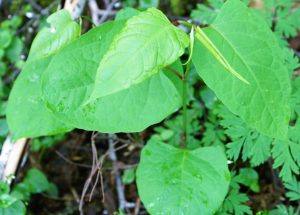
The valley is also home to the Wynoochee River, 63.5 miles long with its headwaters located in the Olympic Mountains. The River is important to fall chinook, Coho, chum, cutthroat, winter and summer steelhead fishery.
Unknown to many, the invasive Japanese knotweed also calls the Wynoochee home. Last year, the Criswell’s were contacted by Kiley Smith, Grays Harbor Weed Board Coordinator. Japanese knotweed was discovered growing in the upper Wynoochee Valley and known to be growing on the Criswell’s land. At Kiley’s invitation, Robert and Lecia went to a community meeting to learn more about knotweed.
“It’s important for folks to realize that Japanese knotweed is here, how nasty it is, and how to work with the county and others to effectively get rid of it. Cutting it with a brush hog or mowing it just makes it spread and grow more,” said Robert. (Note: Contact one of the organizations listed at bottom of the article to cooperate with a licensed pesticide applicator to effectively treat the Japanese knotweed.)
Once Celebrated as an Ornamental Plant
A native of Asia, Japanese knotweed was brought to the United States and was planted in gardens and used for erosion control along roadways and embankments. Early in the 1900s, reports of naturalizations of Japanese knotweed increased rapidly.
Japanese Knotweed – a Noxious Weed
Japanese knotweed (Fallopia japonica) was listed as a class B noxious weed in Washington in 1995. The plant likes roads, streambeds, moist wet places, volcanic slopes, parking lots — and the middle of forests.
Japanese Knotweed Impact on the Wynoochee and other Chehalis Basin Rivers
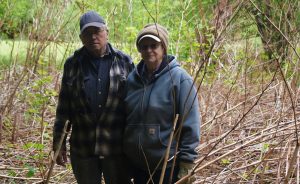
Japanese knotweed is problematic since it grows vigorously and creates dense colonies where virtually no sunlight hits the ground. Because of this, knotweed limits the growth of native plant species. Japanese knotweed also creates bank erosion problems since trees including our native Red alder, and Big Leaf Maple cannot grow in a knotweed monoculture. These native trees are important to shade the river; and dead trees and woody debris feed the bugs who feed the salmon. Japanese knotweed thickets also clog small waterways to further contribute to flooding.
2019 Knotweed Treatment
After attending the Japanese knotweed meeting, Robert and Lecia contacted their neighbors. They let them know that with the county’s help, they too could get Japanese knotweed treated on their land. The Criswell’s received no resistance from their neighbors, and they attributed this to the fact that Robert and Lecia have lived in valley for decades.
With the Criswell’s help, the county is now working with twelve Wynoochee River landowners. Ninety-five acres of knotweed have been treated, with the expectation that treatment continue a minimum of three years.
When walking around their land and looking at the recently treated patch of the invasive Japanese knotweed, Robert said, “As you can see, the first year of treatment is working… This stuff just takes over everything. Some people don’t realize that this stuff goes from here to the ocean. We were very happy when Kiley and crew said that they would come out and do it (treat the knotweed).”
Lecia added, “Kiley is a real polite person, and always got permission before going on our land. It is quite easy to work with her.”
Native Coyote Bush – A Better Fall Food for Bees
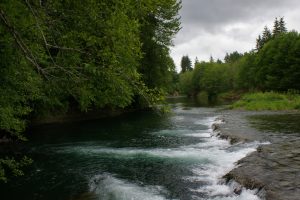
Some landowners are reluctant to treat the Japanese knotweed since it provides good fall food for their honeybees. However, there are several native plants that provide bees with important fall food. The Xerces Society website has a link: https://xerces.org/pollinator-conservation/pollinator-friendly-plant-lists to Pollinator Plants of the Maritime Northwest Region. A fall food plant for bees is Coyote Bush (Baccharis pilularis) which Xerces recommends planting on your land.
When talking about planting plants, Lecia said, “just the other day, someone I know posted a picture of a pretty plant on Facebook. My suggestion, it might look pretty but learn all you can about it before you plant it. Just don’t plant stuff that you don’t know what it is.”
Robert went on the say, “we want our place along the river for our family, grandkids as well as future generations to enjoy well into the future. It will never be for sale.”
Ready to get rid of the Japanese knotweed on your property? For more information, contact:
Grays Harbor: Grays Harbor Weed Board Coordinator Kiley Smith, 360-482-2265, kiley.smith2@wsu.edu
Lewis County: 360-740-1215, lcweeds@lewiscounty.wa.gov
Mason Conservation District: 360-427-9436
Thurston CountyNoxious Weeds and Lake Management: 360-786-5576, tcweeds@thurston.wa.us
Washington Noxious Weed Control Board
Written by Kathy Jacobson, for the Chehalis Basin Lead Entity as part of their Watershed Hero series. If you are interested in restoring salmon habitat in a creek near you, please visit the Chehalis Lead Entity website or contact the Chehalis Basin Lead Entity’s Coordinator, kharma@chehalistribe.org for more information.















